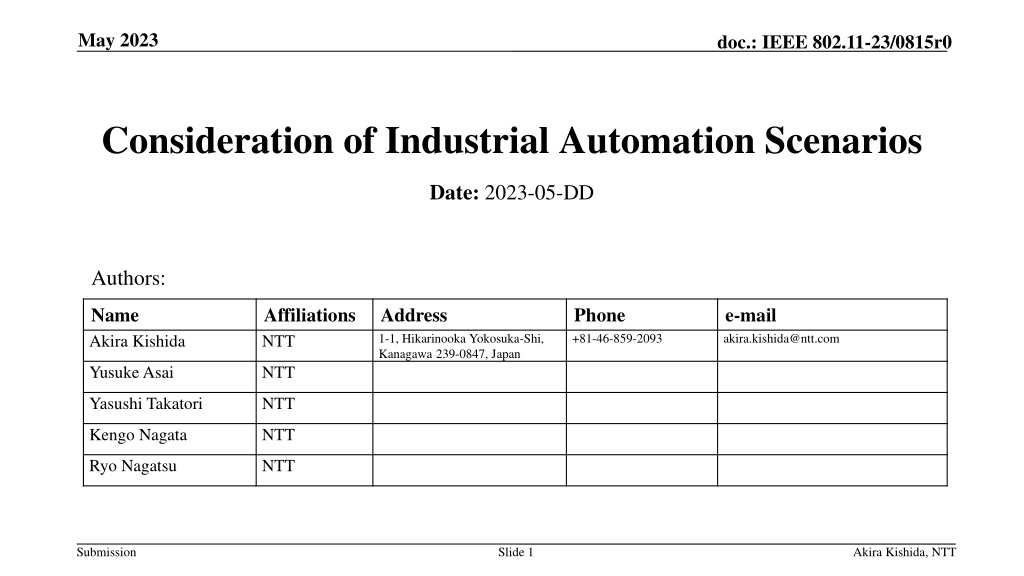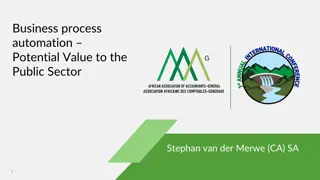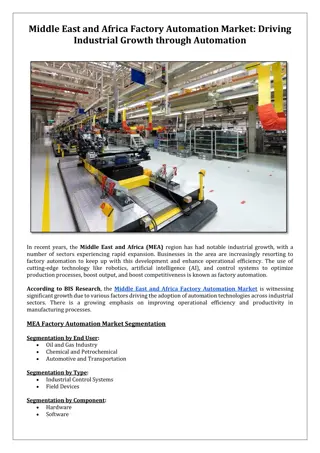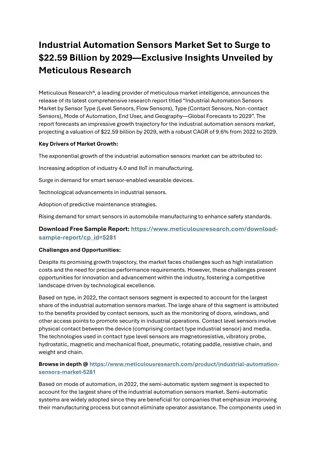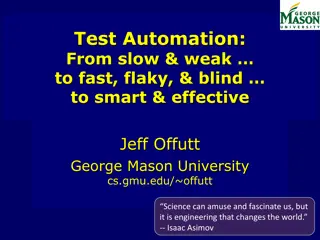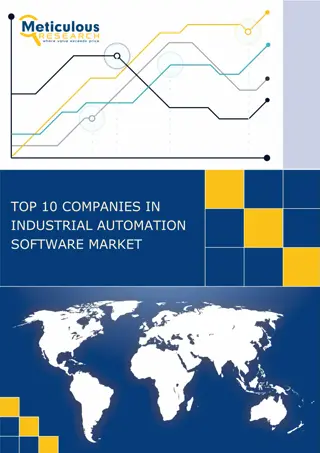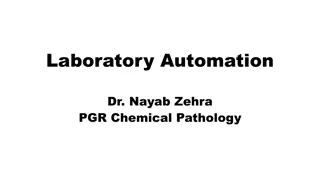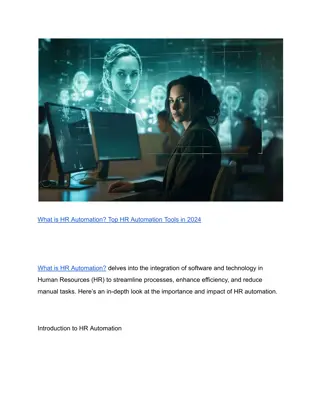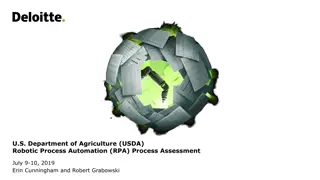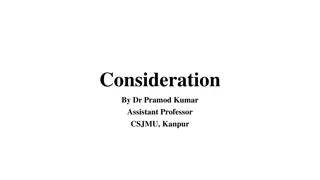Consideration of Industrial Automation Scenarios
This document, authored by Akira Kishida from NTT, delves into the considerations surrounding industrial automation scenarios within the context of IEEE 802.11 standards. The paper identifies key aspects relevant to industrial automation, providing insights into potential advancements in this field. Addressing the unique requirements of industrial environments, the document aims to contribute to the ongoing discussion on enhancing connectivity and communication technologies for industrial automation applications.
Download Presentation

Please find below an Image/Link to download the presentation.
The content on the website is provided AS IS for your information and personal use only. It may not be sold, licensed, or shared on other websites without obtaining consent from the author.If you encounter any issues during the download, it is possible that the publisher has removed the file from their server.
You are allowed to download the files provided on this website for personal or commercial use, subject to the condition that they are used lawfully. All files are the property of their respective owners.
The content on the website is provided AS IS for your information and personal use only. It may not be sold, licensed, or shared on other websites without obtaining consent from the author.
E N D
Presentation Transcript
May 2023 doc.: IEEE 802.11-23/0815r0 Consideration of Industrial Automation Scenarios Date: 2023-05-DD Authors: Name Akira Kishida Affiliations NTT Address 1-1, Hikarinooka Yokosuka-Shi, Kanagawa 239-0847, Japan Phone +81-46-859-2093 e-mail akira.kishida@ntt.com Yusuke Asai NTT Yasushi Takatori NTT Kengo Nagata NTT Ryo Nagatsu NTT Submission Slide 1 Akira Kishida, NTT
May 2023 doc.: IEEE 802.11-23/0815r0 Introduction The UHR PAR & CSD [1] are confirmed in the 2023 March Plenary, and UHR SG / TGbn will proceed to realize the Scope of the Project in the PAR. TGax created Simulation Scenarios [2] and Evaluation Methodologies [3] documents. Creating these documents needs a lot of effort and time. Therefore, TGbe did not create these. In the UHR, scenarios of each use case should be considered to provide materials to clarify the purpose and effect of the technologies under consideration, such as multi-AP and low latency technologies, etc. These efforts are different from creating simulation scenarios or evaluation methodologies. This contribution initiates discussions regarding scenarios of industrial automation [4] which is the target use case of the UHR. Submission Slide 2 Akira Kishida, NTT
May 2023 doc.: IEEE 802.11-23/0815r0 UHR PAR [1] 5.2.b Scope of the project: This amendment defines modifications to both the IEEE Std 802.11 physical layers (PHY) and the IEEE Std 802.11 Medium Access Control (MAC) that enhance Wireless Local Area Network (WLAN) reliability by enabling, in scenarios of an isolated Basic Service Set (BSS) or of overlapping BSSs: ? ?at least one mode of operation capable of increasing throughput, as measured at the MAC data service Access Point, at different Signal to Interference and Noise Ratio (SINR) levels (Rate-vs-Range), compared to Extremely High Throughput MAC/PHY operation ? ?at least one mode of operation capable of improving the tail of the latency distribution and jitter compared to Extremely High Throughput MAC/PHY operation, with mobility between BSSs and ? ?at least one mode of operation capable of improving efficient use of the medium compared to Extremely High Throughput MAC/PHY operation. 5.5 Need for the Project: Use of WLANs based on IEEE 802.11 technology continues to grow and diversify over many market segments including residential, enterprise, industrial and agriculture. More stringent requirements are needed to meet the demands of new applications (including metaverse [1], augmented and virtual reality [2], robotics, industrial automation for industrial IoT, logistics and smart agriculture [3]) and to improve reliability (i.e., stable and consistent connectivity and quality of service). Submission Slide 3 Akira Kishida, NTT
May 2023 doc.: IEEE 802.11-23/0815r0 Recap: TGax Simulation Scenarios [2] The Simulation Scenarios document in TGax [2] analyzes and summarizes topologies of distribution of APs and STAs in dense environment scenarios. Scenario Channel ~Traffic Topology Management Homogeneity Name Model Model A - Apartment building e.g. ~10m x 10m apartments in a multi-floor building ~10s of STAs/AP, P2P pairs 1 Residential Unmanaged Indoor Flat Home B - Dense small BSSs with clusters e.g. ~10-20m inter AP distance, ~100s of STAs/AP, P2P pairs Though these considerations are also beneficial for the UHR, the enterprise scenario in the document cannot apply to industrial automation scenarios as is. 2 Enterprise Enterprise Managed Indoor Flat C - Dense small BSSs, uniform e.g. ~10-20m inter AP distance ~100s of STAs/AP, P2P pairs Indoor Small BSS Hotspot 3 Mobile D - Large BSSs, uniform e.g. 100-200m inter AP distance ~100s of STAs/AP, P2P pairs Outdoor Large BSS Hotspot 4 Managed Flat Mobile Outdoor Outdoor Large BSS Hotspot + Residential Therefore, we should consider a new topology for industrial automation. Mobile + Home Managed + Unmanaged 4a D+A Hierarchical Submission Slide 4 Akira Kishida, NTT
May 2023 doc.: IEEE 802.11-23/0815r0 Considerations for Industrial Automation Scenarios For industrial automation scenarios, the following use cases are considered by several white papers[5]-[11] for future industrial automation. AGV (Automated Ground Vehicle) / AMR (Autonomous Mobile Robot) Delivering parts, products, and materials. Involving communication between robots and a control system, including guidance control, process data exchange, video/image, and emergency stop. Sensors Periodical report of information to the control system. Numerous sensors are deployed densely. Robot/drone motion control Remote operation with haptics communication, programmed robot operation with emergency stop. Video transfer High-definition video transferring from cameras. AR/VR/XR Walk-by health monitoring, combining video feed with overlaid contextual information. Assembly line Combination of AGV/AMR, sensors, robot/drone motion control, and video transfer. Submission Slide 5 Akira Kishida, NTT
May 2023 doc.: IEEE 802.11-23/0815r0 KPIs and Requirements for AGV/AMR in Whitepapers RTA report[5] WBA[6] Avnu Alliance[7][8] 1-10 ms (cyclic) 10-100 ms (events) - 99 to 99.99% - 100 5G-ACIA[9] IOWN GF[10] Latency 10-50 ms < 10-20 ms 10-100 ms (Video-operated remote control) - 99.9999% - 100 10-100 ms Jitter Reliability Speed Number of AGVs/AMRs per area Note < 1ms 99.9999% < 50 km/h - - 99.9999% - 100 (300) 99 to 99.9% - - Values are from Class A applications (AGV). Another KPI (Handoff times) depend on latency and speed. Values are cited by combining two documents [6] and [7]. Cyclic time is adopted as latency, and availability is adopted as reliability. Values are cited by combining two Robot manipulator domains in [9]. Submission Slide 6 Akira Kishida, NTT
May 2023 doc.: IEEE 802.11-23/0815r0 Gap Analysis Taking AGV/AMR as an example, UHR needs to consider technologies that meet the following requirements. Latency Almost whitepapers indicate that AGV/AMR use case requires 10 ms at the lowest. (with cyclic control or motion control, the requirement becomes strict for 1-10 ms) Though this value will be achieved using existing Wi-Fi technologies, mixed traffic in which different communication requirements coexist, such as sensor and AGV/AMR, will be supported in future industrial automation scenarios[11]. We should fulfill the requirement in such a mixed traffic environment. Moreover, we should consider supporting the mobility of AGV/AMRs, vast traffic from numerous sensors, and interferences. Besides, two types of latency-sensitive traffic (periodic/cyclic, sporadic/event) should be considered. Reliability Requirement of reliability varies according to each whitepaper (99 to 99.9999% will be required). Almost whitepapers define reliability as the percentage of packets expected to be received within the latency bound (or not defined precisely). Wi-Fi systems are unlicensed; therefore, it isn t easy to guarantee the requirement of that reliability. However, we should challenge to cover the condition in the UHR. (The UHR indicates Ultra High Reliability. ) Submission Slide 7 Akira Kishida, NTT
May 2023 doc.: IEEE 802.11-23/0815r0 Challenges for industrial automation in UHR For the technology proposed in the UHR to be effective in industrial automation scenarios, it is necessary to consider the following items. Candidate features that can fulfill the requirements of industrial automation. Channel access enhancement (including enhancement of R-TWT, triggered access, and OFDMA) Preemption Multi-AP enhancement Overhead reduction Wireless TSN And other novel technologies Topologies for industrial automation Network topologies simulating factories or plants. Adopting multi-APs, AGVs/AMRs, and sensors for the topologies. Submission Slide 8 Akira Kishida, NTT
May 2023 doc.: IEEE 802.11-23/0815r0 Summary Though TGax Simulation Scenarios analyzes and summarizes topologies of Wi-Fi dense environment scenarios, they do not correspond to some use cases of the UHR, such as industrial automation. For the technology proposed in the UHR to be effective in industrial automation scenarios, it is necessary to consider candidate technologies and network topologies. Submission Slide 9 Akira Kishida, NTT
May 2023 doc.: IEEE 802.11-23/0815r0 SP Do you agree that continuing consideration of network topologies for industrial automation in the UHR is helpful? -Yes -No -Abstain Submission Slide 10 Akira Kishida, NTT
May 2023 doc.: IEEE 802.11-23/0815r0 References [1] Laurent Cariou, et al., UHR proposed PAR, IEEE 802.11-23/0480r0 [2] Simone Merlin, et al., Simulation Scenarios, IEEE 802.11-14/0980r16 [3] Ron Porat, et al., Evaluation Methodology, IEEE 802.11-14/0571r12 [4] Akira Kishida, et al., Considerations on UHR PAR and KPIs, IEEE 802.11- 22/1919r5 [5] Kate Meng, et al., RTA report draft, IEEE 802.11-18/2009r6 [6] Wi-Fi 6/6E for Industrial IoT, WBA (Wireless Broadband Alliance), May 2018. [7] Wireless TSN Definitions, Use Cases & Standards Roadmap White Paper, Avnu Alliance, Mar 2020. [8] Wireless TSN: Market Expectations, Capabilities, & Certification, Avnu Alliance, Feb 2022. [9] 5G for Connected Industries and Automation, 5G-ACIA, Feb 2019. [10] IOWN GF-Cyber-Physical System Use Case, IOWN Global Forum, 2021. [11] 5G Evolution and 6G, NTT DOCOMO, Jan 2023. Submission Slide 11 Akira Kishida, NTT
